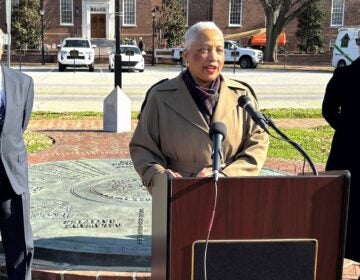Sign Control Working Group finishes first round of civic engagement
The inter-agency Sign Control Working Group wrapped up its first round of civic engagement Friday with a public meeting at the City Planning Commission. The group also met on Thursday with CDC representatives and commercial corridor managers in a meeting co-hosted by the Philadelphia Association of Community Development Corporations.
In all, the working group held five meetings with different constituent groups, each aimed at spurring public participation in re-writing the sign chapter of the new zoning code. The Zoning Code Commission had earlier decided to pass the bulk of the new zoning code and rewrite the unwieldy sign regulations later.
The group, led by former ZCC director Eva Gladstein, will present a rough draft of the sign chapter at a Planning Commission meeting on Tuesday. It will then seek public comment on the draft, and issue a second draft in April. It plans to send a finished draft to City Council in May in order to have the chapter inserted into the new zoning code before it takes effect in August.
Thursday’s meeting with CDC representatives and commercial corridor managers brought together a unique set of interests. While many of the meeting’s participants were interested in giving the zoning code some level of aesthetic control, many also wanted to make sure businesses maintain creative control of how they promote themselves.
A question was raised, for example, about whether window displays would be considered signs in the new code. Many commercial corridors have window-display contests during holiday season and other occasions, and business owners see these as an important way to draw customers.
Participants in some other meetings had expressed support for some kind of regulation for signs that are behind glass but nevertheless project messages into public space. The participants at Thursday’s meeting seemed to want to maintain that indoor store displays should be outside the reach of the zoning code.
One participant offered the idea of having a Signage Design Review similar to the Civic Design Review for major development projects in the new zoning code, an idea that had been raised at earlier meetings. Another participant suggested a Sign Area Bonus—similar to the developer’s Floor Area Bonus—for shop owners who use certain materials or characteristics in their signs.
“This group is an interesting blend of several interests,” Gladstein said. “ … They’re concerned both about the ability of the business to advertise, but they’re concerned also about how the business looks to the resident, the shopper, the employee, or the new business coming in.”
Friday’s meeting, which was open to the public, drew similar feedback. Like most of the five conversations on sign control reform, Friday’s landed on a few key areas of concern.
For example:
- How much can the zoning code do? Not everything. For one thing, signs that rest on the sidewalk rather than attach to the building are beyond the purview of zoning. These signs, such as A-frame chalkboards, are regulated by the Streets Department, rather than by the zoning code.
- What classifies as a sign? In Friday’s discussion, one participant commented on a company he was familiar with having to get a sign license for a portion of the building painted the bright-red color of its logo. He seemed to think that was a zoning overstep, but other participants thought the code should be able to regulate any commercial messages on a building.
Many participants asked about the distinction between signs and art. Is a sign with no text and only a logo still a sign? While the working group members were not at the meetings to answer questions, but rather to hear feedback, they did indicate that a sign with no words could still be a sign.
- How should digital signs be regulated? Some participants have pointed out that a highway billboard which switches between ten different digital messages could theoretically be considered ten billboards. It doesn’t appear that the working group intends to actually consider it as such, but the point is: digital signs are new territory. The old code doesn’t deal with them, but they’re only going to grow more popular.
- How much signage is too much? There seems to have a been a loose consensus across the five constituent groups that visual sign clutter is a bad thing. There is no consensus, however, on how many signs it takes for an area to be cluttered. The new sign control chapter will have to put a number on, for example, how many square feet of signage a store can have per linear foot of storefront. Participants’ opinions on what that number should be differed widely.
- Where should billboard removal be incentivized? One of the main questions the sign working group asked each participant group was whether the non-accessory sign (billboard) replacement ratio should be changed from the current 1-to-1 to, say, 3-to-1. The group also wanted input on where, geographically, removing existing billboards should be incentivized. Based on observations of these conversations, there didn’t seem to be a particular area where people want billboards removed—aside from their own neighborhoods.
One thing most participants could agree on is that the current regulations desperately need to be reworked.
“A major concern I’ve encountered among businesses is the lack of clarity around the size and type of sign they can display and confusion over which City agency is in charge of enforcing regulations,” said Stephanie Odell, a graduate of the Citizens Planning Institute and member of Lower Moyamensing Civic Association. “The current system appears arbitrary and the rules seem to shift within the same block, allowing one office to display a large, projecting sign while a similar establishment is permitted to only have a small, flat display.”
Gladstein and the sign working group emphasized that their first priority in reforming the sign regulations is the same as it was for reforming the rest of the zoning code: creating clear, predictable, citywide rules, as much as possible. While Gladstein admitted feedback from the final two meetings won’t be included in the first draft, she said the group would work it into the April draft.
The group has also been soliciting public input through a survey posted on zoningmatters.org.
“We were very pleased that the meetings stimulated active discussion from a range of stakeholders regarding sign controls,” Gladstein said. “…We will continue to encourage business owners to weigh in as the process moves forward. We are looking forward to receiving written comments on the first draft of the sign controls chapter after it is released next week.”
Contact the reporter at jaredbrey@gmail.com and follow him on Twitter @jaredbrey
WHYY is your source for fact-based, in-depth journalism and information. As a nonprofit organization, we rely on financial support from readers like you. Please give today.








